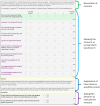How to measure the effectiveness of recovery community centers: insights gained from a nationwide survey of directors of RCCs
- PMID: 40771233
- PMCID: PMC12326742
- DOI: 10.3389/fpubh.2025.1532812
How to measure the effectiveness of recovery community centers: insights gained from a nationwide survey of directors of RCCs
Abstract
Objective: Recovery community centers (RCCs) are a rapidly growing source of support for many Americans seeking or in recovery from substance use disorder. Research that examines the effectiveness of RCCs is critically needed. Determining how the "effectiveness" of RCCs ought to be measured, however, is challenging, because RCCs seek to confer benefits on multiple levels and because recovery is a multi-faceted construct. RCC directors are uniquely suited to provide insight into what outcome measures may be viable to use to capture the impact of RCCs on their participants.
Methods: As part of a nationwide survey of RCCs directors (n = 122/198, 62% response rate), we presented seven measures to RCC directors: process measures (Client Satisfaction Questionnaire (CSQ-8); a list of ways in which RCCs confer benefit) and longer term outcome measures (Brief Assessment of Recovery Capital (BARC-10); EUROHIS-QOL; Substance Use Recovery Evaluator (SURE); PERMA Profiler; a list of life goals). We then asked RCC directors if they expected that RCC participants would show progress over time on these measures (yes/no), if the measure would be useful to demonstrate the impact of their RCC (yes/no), and which measure they felt was the best measure of the positive impact RCCs can make on RCC participants.
Results: All measures had considerable buy-in from RCC directors: 87% or more of RCC directors said RCC participants would show progress on each measure, and 72% or more said that each measure would be useful to demonstrate the impact of their RCC. Most frequently, RCC directors endorsed as useful the list of ways in which RCCs confer benefit, the list of life goals, and the BARC-10 (≥95% of RCC directors each). RCC directors were split on which measure would be the best measure, with no single measure exceeding 26% of RCC directors rating it as the best of the seven presented scales.
Conclusion: Several existing scales resonate with RCC directors, yet little consensus regarding a single primary outcome variable exists. Close collaboration with RCCs is needed to ensure that research on the effectiveness of RCCs is congruent with how RCCs function and seek to confer benefit.
Keywords: addiction; definition of recovery; measurement of outcomes; measuring peer impact; peer recovery support services; recovery; recovery community centers; substance use disorder.
Copyright © 2025 Hoeppner, Williamson, Simpson, DeCristofaro, Weerts, Riggs, Futter, Mericle, Rutherford, Hoffman, Rao, McCarthy, Ojeda and Hoeppner.
Conflict of interest statement
The authors declare that the research was conducted in the absence of any commercial or financial relationships that could be construed as a potential conflict of interest.
Figures
References
-
- White WL, Kelly JF, Roth JD. New addiction-recovery support institutions: mobilizing support beyond professional addiction treatment and recovery mutual aid. J Groups Addict Recover. (2012) 7:297–317. 10.1080/1556035X.2012.705719 - DOI
-
- Valentine P. “Peer-based recovery support services within a recovery community organization: the CCAR experience”. In: Kelly JF, White WL, Kelly JF, White WL, editors. Addiction Recovery Management: Theory, Research and Practice. Humana Press (2011). p. 259–79. Current clinical psychiatry. 10.1007/978-1-60327-960-4_14 - DOI
-
- United States. National Drug Control Strategy. Washington, DC: Office of National Drug Control Policy; (2022).
MeSH terms
LinkOut - more resources
Full Text Sources
Medical
Research Materials


